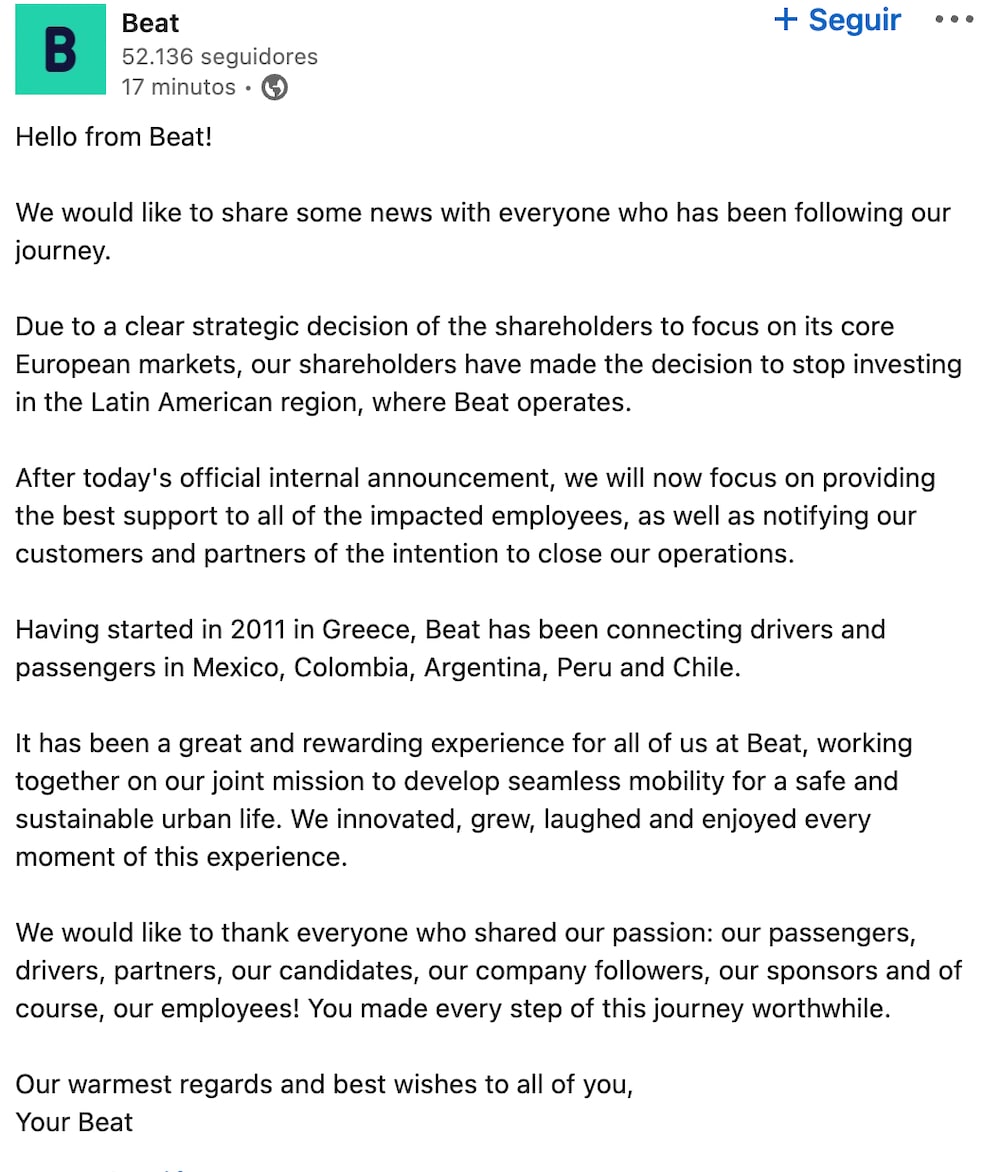Bloomberg Línea — Ride-hailing app Beat announced on Tuesday it is exiting Argentina, Peru and Mexico from November 9.
Through a message to its users, the company created as a joint venture between BMW and Daimler in 2011 in Greece announced that as of Wednesday it will no longer be possible to make trips with the application, although users’ accounts will continue to be active until December 7.
Sources close to the company confirmed to Bloomberg Línea that the closure of business in the three Latin American countries is the result of a decision by FREE NOW and is related to the current international situation.
Likewise, the employees of the Argentine subsidiary were informed of their dismissal on Tuesday.
Through its official LinkedIn profile, the company communicated: “Due to a clear strategic decision of the shareholders to focus on their main European markets, our shareholders have taken the decision to stop investing in the Latin American region, where Beat operates.”

The company has been operating in Latin America for more than a decade, in Mexico, Colombia, Argentina, Peru and Chile, and although for now it seems that its presence will be reduced to just Colombia and Chile. Sources close to the company in Colombia told Bloomberg Línea that Beat is already terminating contracts with communications agencies and will soon also cease to operate there.
Truncated plans for Argentina and Peru
The company landed in Argentina in November 2019, by the end of 2021 it had accounted for 161 million kilometers (100 million miles) traveled, with profits of $3.9 billion for the more than 130,000 drivers registered, and where it had 2.2 million users.
“By 2022, we project that the accumulated profit among drivers will be $9.44 billion”, Patricia Jebsen, Beat Argentina’s GM said in a conversation with Bloomberg Línea just one year ago.
She added that, “in Buenos Aires, we still have a lot of room for growth (...) Our focus in the coming months will be to improve service levels”, referring to the launch of Beat Go, for high-demand and low-supply areas, and Corp, a service exclusively for companies.
Sources close to Beat said the local operation was profitable, and this had nothing to do with the decision to exit the country.
As regards Peru, in September this year Beat said it had plans to enter other regions besides Lima, the capital. Beat Peru’s country manager, Alejandro Dubreil, told El Comercio newspaper that an expansion to cities such as Cusco, Arequipa and others in the north was being considered for 2023.
In the meantime, the company was concentrating on expanding its coverage in different areas of Lima. Beat celebrated eight years in the Peruvian market in 2022 and competed in the Andean country with other applications such as DiDi, Uber, Easy Taxi and Cabify, among others.
From Peru, Beat communicated that “the decision to shut down our app in Peru is due to the closure of our operations globally”.
The company said the closure of Beat’s operations will take effect gradually in all the countries where it operates.
“This has been a decision purely by our investors due to the redirection they have decided to make for their investments in the current global context,” the company said.

Mexico, an electric business
Beat arrived in Mexico in February 2019, landing in Mexico City, Monterrey and Guadalajara, and by the end of that year it was available in seven more cities, including Querétaro, Aguascalientes, Villahermosa and Saltillo.
In 2020 it launched its electro-mobility services in Mexico with Tesla cars, and in 2022 introduced JAC EJ7 cars.
In April of this year, Bloomberg Línea spoke with Enrique Mendoza, Beat’s general manager in Mexico, about the construction of an innovation center in the country, the amount of investment for which was not disclosed, but Mendoza said the company was looking to develop the Latin American market and talent.
With the hub in Mexico, Beat’s goal was to recruit Latin American talent as programmers and engineers to solve mobility challenges in the region. The center would work globally with Beat’s other two hubs, in Amsterdam and Athens, among others, to continue the democratization of electro-mobility.
By the end of this year, Beat’s goal was to quadruple electric vehicle travel in Mexico City, Mendoza said in April, and, as a consequence, generate a positive environmental impact.
“If we achieve this travel target we have in our sights, we will be saving the emission of 3,000 tons of carbon dioxide, or something equivalent to 200 vehicles,” he said.
With additional reporting by Sebastián Osorio Idárraga.





